
|   |

|   |
Sangeet Natak Akademi's Nritya Pratibha - B Venkat, Visakhapatnam e-mail: bhavanvitha@gmail.com June 3, 2011 Visakhapatnam had the pleasure of hosting and enjoying the performance of promising young dancers, courtesy Sangeet Natak Akademi and VMDA. Fourteen performances, eleven dance styles, three days. SNA's 'Nritya Pratibha' from April 5-7, 2011 was a bouquet with different flowers strung into a fragrant garland. SNA's initiative and the efforts of the team that organized the event are praiseworthy. The festival was about opportunity to upcoming young dancers with the right mix of talent, youthful energy with maturity, mastery of advanced concepts of classical dances with innovativeness. Nritya Pratibha impressed on two fronts, its content and in its presentation. There was a trend observed in the selection of items performed, the choice of mythological female characters like Surpanakha, Gandhari, Poothana, Draupadi, even a Gollabhama, (two of them played by men). Multiple styles, different musical instruments, beautiful ragas, many languages, thought provoking practices (having harathi, stage arrangement), a veritable cultural treat it turned out to be. We witnessed a dancer interacting with the rasikas, another dancer seated all through her performance, another was a warrior hunting - veera rasam, and one was a butterfly flitting from one flower to another. All performances were restricted to 30-45 minutes, a little short of what the dancers needed. The three Kuchipudi performances were characterized with high energy. In the case of the all the three dancers, the performers had one of their parents involved in performance too. Parampara. 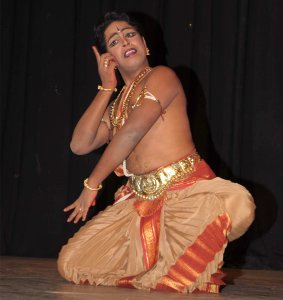 Aditya Bulli Brahmam On the first day 5th of April, Aditya Bulli Brahmam performed Kuchipudi. He presented two items - "Sogasuga Mridanga Talamu," Thyagaraja krithi, Sriranjani ragam, Rupaka thalam and "Aadenamma Harudu" of Puliyar Doraiswamy, Paraj, Adi, dance compositions of Guru Bala Kondala Rao. The jathis in the items were fast paced, and demanded reservoirs of energy and stamina. He was full of zeal and it showed. In the second item, the composition provided an opportunity to the dancer to display abhinayam- the navarasas at "navarasammuloluka momu chirunavvau...." The nattuvangam was by Bala Kondala Rao, guru and mother of Aditya. April 6, 2011 featured Siddhendra Vara Prasad Vedantam, who performed an extract of Gollakalapam that has Kuchipudi specific Streevesham in conversation with a Brahmin. His performance and the sutradhari's dialogues with the supporting team were well received. Apparently the item was chosen to bring to the audience this rare kalapam (rare performer too) with scientific content. Not an easy task for a man to role play and explain the process that happens in stages in a mother's womb, but this barrier was easily surmounted. Siddhendra's footwork in the jathis in contrast (as the character is female) was quite strong and speaking. The abhinaya was dramatic and typical of bhagavathula tradition. Guru Radheyshyam, guru and father of Siddhendra, performed the role of a Brahmin. On April 7, 2011 Bhagavathula Sowmya chose two items (Annamayya kirtana and Tarangam) for her thirty minute presentation and performed them with an ease that comes from her experience. The distinctness in styles of Kuchipudi came to the fore with the performances of the three dancers. Sowmya was quick paced, firm in her footwork and in the dramatic moments, flourished. The elements of the bhagavathula tradition were telling. She excelled in the tarangam "nanda nandana." The use of brass plate was flawless. Her father and guru B Venkata Rama Sarma accompanied her. 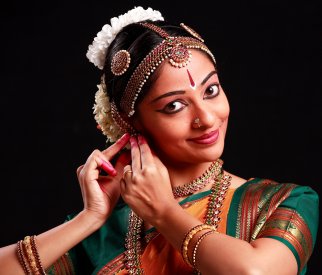 Parvathy Menon Parvathy Menon's first item was "Shankara Sri Giri Natha Prabho" of Maharaja Swathi Tirunal, choreography of Guru Leela Samson, describing Lord Nataraja's ananda thandavam performed at Chidambaram. After turning Manmadha into ashes, when Shiva smeared the ashes on his forehead, the dancer's ability to evoke rasa amongst the audience was evident. Credit goes to the composer for the in depth understanding of the spiritual content in that one act. As the item came to an end, etched in the mind was the vision of seeing Lord Shiva in eternity and the dhamuruka in his hand played divinely, and the artist's trance. The second item was a javali "Sakhi Prana Sakudittlu Jesene" of Dharmapuri Subbarayar. Explaining the nayika's pain to her sakhi that her beloved had left her and sought another woman, that the nayaka, her life, doing such a thing is to her disbelief, I realized that the dancer as nayika now turned into a victim of Manmadha in this item! Such transformation speaks high of a dancer's talent and mastery of technique. The third item was Hindolam Thillana. There was this soft and subtle lasyam, so delicately beautiful in Parvathy's dance. She performs as a duo with her husband Shijith Nambiar, also a reputed dancer, and Visakhapatnam hopefully would see them performing together in the near future. 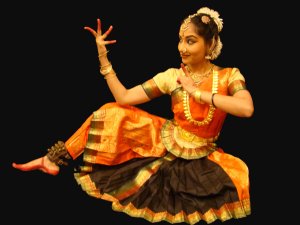 Sneha Devanandan Sneha Devanandan was precise and rich in expression. The first item was Shiva Sthuthi "Aadiya paadathai darishika vendum" in raga Panthuvaraali. Sneha described Lord Shiva with a sloka, then depicted the desire of a bhaktha to witness the tandava of Lord Nataraja. The episode of Shiva destroying the demon with just the power from his mind is shown in brief. Nataraja places his foot on the demon and is shown to do the tandava on him. The item ended with three different poses of Lord Nataraja. There was matching power to the veera rasam from the dance. This was followed by a Devaranama, "Maneyolagaado Govinda" (raga Brindaavani) in Kannada. In this, we found Yasodha in different emotional modes full of vatsalyam at one time and frustrated at Krishna's pranks, pleading to convince him in yet another. Yashodha applies sandal paste, gives him snacks to eat, adorns him with jewels and new clothes and enjoys the sight of her son who looks so wonderful! Vatsalya bhava at its best as Yashoda tells her son about how everyone is calling him a thief and that he is always in the company of beautiful women. She pleads with him to stop such behavior and showers him with affection. The third item Devi stuthi, "Yaarikkum adangaada Neeli" in raga Abhogi, started with a slokam on goddess Kali. The item shows the power and dominance of Goddess Kali who controls birth and death, the trimurthis and every other power in existence. It also shows how she breaks the pride of Lord Shiva and takes her as his half by being the Ardhanarishwara. Sneha brings in her distinct mark - energy, immaculate geometry in presenting jathis with precision. I have to say this – it's like visual poetry in geometry! The items were cleverly chosen so as to give the dancer scope to showcase her versatile skills in abhinaya. The audience watched her dance in rapt attention and photographers clicked until their hands ached. The recital concluded with a Mangalam in praise of Lord Vishnu. Lonisha Vijayanath from Ernakulam initiated her solo Mohiniyattam performance with Ganesha Stuthi, a cholkettu, invocational compositions normally in praise of Lord Ganesha – the remover of obstacles. The second item brought her own choreography of 'Gandhari.' The "dance of the enchantress" needed clever interpretation to depict the sorrow and the angst. Gandhari was adapted from the 'Sthreeparvam' of Mahabharatha which discusses the life of Gandhari, the reigning queen of Kuru Dynasty. Gandhari, the woman, has been analyzed and interpreted from a different perspective. Lonisha mentioned that she was inspired by an article by Prof. Geetha. The Varnam begins with Gandhari appearing at the battlefield of Kurukshetra to witness the heartrending sight of her dead sons amidst the destruction and devastation, and holds Lord Krishna responsible for her situation. The final piece was an invocation slokam on Goddess Parvathi. In Kathakali by Abin Babu, the artistes enacted an episode from Duryodhana Vadha, where Krishna addresses the concerns of Draupadi that takes place after the vanavaasa. A young girl seated next to me was in wonder of the Draupadi character. She got me to focus on the endless serene expression on Draupadi's face. The limited time was a constraint. Chhau was presented by artistes of Chhau Kendra, Baripada and Seraikella. Dancers from the academy enacted dance of a warrior hunting, a dancer wonderfully flitting from a flower to flower like a butterfly, and the romantic duo Radha and Krishna. The masks too convey wonderful expressions! The Mayurbhanj Chhau and Seraikella Chhau brought about dance themes that stood out. A young Brahmin boy's thread ceremony and the practice of crossing three lines are as much a realization of the customs and practices of the region as the expression of religious sanctity. The dancer depicted in slow motion movements like raising the knee high and placing each step of his walk with caution as if to avoid unseen barriers, reminding us that nothing is beyond for a "dance experience." Nangiarkoothu performance showed the intensity of Mukhajabhinayam. TR Saritha enacted Poothana episode that took her entire forty five minute spell; yes, it was a spell cast by the wiliness in her eyes deceiving Lord Krishna with motherly love. Here was a dance entirely dedicated to facial expressions that were intense. Poothana was at once a mother and the scheming vamp. Her eyebrows almost continuously fluttering lending various feelings, I could sense other dancers taking the tutorial of how powerful "drishti bedhas" can be. The eventual pain and death of Poothana were executed with expression of disbelief and shock. The delicate voice from a girl sitting on the stage, singing softly and the supporting team proved to be a new experience. 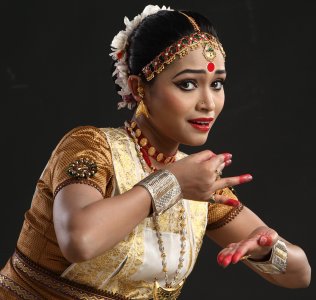 Mridusmita Das Mridusmita Das from Guwahati connected to the audience right from the moment she started her Sattriya performance. The first piece, a beautiful expressive Vandana sung in raag Sareng was an item in praise of Lord Krishna - He the beloved son of Vasudev and Devaki, brought up in the palace of the king of Brajdham and the one who killed Kansha. Followed by a pure dance 'Gopi Naach,' Mridhusmita was graceful in the lasya item. Like the Pravesa Daruvu in Kuchipudi, Gopi Naach is also known as Pravesh Naach as it is performed by the lead female characters i.e. the gopikas in their entrance in 'Ankiya Naat.' Then it was 'Ram Katha' in praise of Lord Rama followed by Ram Bijoy, a Bhatima of Ankiya Naat. In Sita's Swayambar how Lord Rama prevailed among all the strong powerful kings' company, how he destroyed Parashurama's pride and married Sita was expressed through innovative choreography. Mridusmita's strength in the lasyam elements stole the show. Dance compositions were by her Guru Ramkrishna Talikdar. Manipuri was presented by Hemolata Devi. As I entered the hall, the song got to me first as I observed the high pitched intonations and the lyrics, the notes, and the newness of it got the audience drawn into a serene, almost in trance performance. She unraveled the Leela of playful Krishna much to the delight of everyone. The multi-colored costume that accentuated the swirls and twirls and the wavy hands proved almost hypnotic. If you haven't been to a Manipuri performance, time to make it now. Hope the December Season in Chennai invites Hemolata. Ayona Bhaduri was splendid in her Odissi performance. After the traditional Mangalacharan, she brought to life Surpanakha, built the intensity and tempo with her transformation into the character. The composer must have studied the closeness of emotions, contrasting ones, to have them juxtaposed and their cause and effect. Katha Surpanaka was about "love of a woman" and its rejection, of "insult" so powerful it led to a war. As much praise and appreciation should go to Sharmila Biswas as it is due to Ayona in this performance. 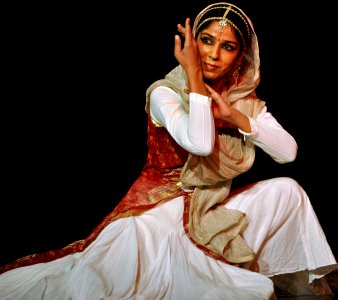 Namrata Pamnani With Guru Kala Krishna on the nattuvangam, A Akhila performed Andhra Natyam on Adhyatma Ramayana, Parasurama Garvabhangam and Sahitya Sthuthi. Namrata Pamnani's Kathak was a magic performance - she made use of her time effectively. Realizing that Visakhapatnam has fewer opportunities to see Kathak, she interacted with audience and made them part of the dance being presented on the stage and what is more, maintained the energy flow two-way. She performed Ram Stotra, jugalbandhi and concluded with an expression of a nayika more concerned with inner beauty and surrender than the outer ornaments and looks. Her performance brought in variety of gat nikas, with stress on different - she mentioned that "supple bodies balance as the speed of nayika's chaal changes." A treat in the form of jugalbandhi was performed with the percussionist. Endless possibilities of shringara came out when she danced as Mugdha Nayika in intense bhava of surrender with sancharis brought in. As the continuous magical swirling and the typical hand movement gained momentum, one could visualize the ascension to divinity of the dancer's mind and thought. Namrata's presentation was in effect a reminder of the possibilities to enhance the audience experience. It is for them that we dance. The SNA event thus met the objectives on both quality and quantity parameters. Wish the organizing team even more success. |